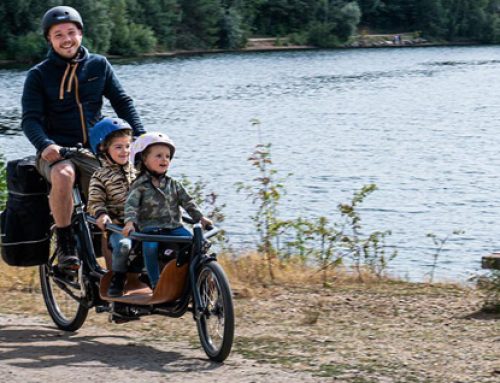In the world of cargo bikes, two popular styles are the 3-wheel cargo bike, often known as a trike, and the 2-wheel long john bike. These bikes serve similar purposes but have distinct differences in design, stability, maneuverability, and load capacity.
Design
3-Wheel Cargo Bike: Typically, a 3-wheel cargo bike has two wheels at the front or the back, with a cargo area positioned either in between the front wheels or behind the rear wheel. This design provides a broader base for stability, making it a popular choice for transporting heavy loads or children. The frame is usually heavier and more robust to support the extra wheel and cargo.
2-Wheel Long John Bike: The long john bike has a long and low cargo area situated between the handlebars and the front wheel. This design keeps the center of gravity low, making it easier to handle, especially at higher speeds. Long john bikes are generally lighter than 3-wheel cargo bikes and offer a more traditional bicycle riding experience.
Stability
3-Wheel Cargo Bike: The three-wheel design offers inherent stability, especially when stationary or moving at low speeds. This makes it an excellent choice for those who need to transport children or pets, as it reduces the risk of tipping over.
2-Wheel Long John Bike: Although less stable when stationary, the long john bike gains stability as it moves. Riders need to balance the bike, much like a standard bicycle, which can be challenging with heavy loads.
Maneuverability
3-Wheel Cargo Bike: The extra wheel can make turning more cumbersome, particularly in tight spaces. Some models have articulated or tilting mechanisms to help with this, but generally, 3-wheelers are less maneuverable than 2-wheelers.
2-Wheel Long John Bike: The long john bike offers superior maneuverability, resembling a traditional bike. It can navigate through traffic and tight spaces more easily than a 3-wheel cargo bike.
Load Capacity
3-Wheel Cargo Bike: These bikes are designed to carry heavier and bulkier loads, making them ideal for grocery shopping, delivery services, or transporting children.
2-Wheel Long John Bike: While they can carry significant loads, long john bikes are better suited for lighter and more streamlined cargo due to their design and balance requirements.
Both 3-wheel cargo bikes and 2-wheel long john bikes have their advantages and disadvantages. The choice largely depends on the specific needs of the rider, such as the type and weight of the cargo, stability requirements, and the riding environment.
Comparison Table
| Feature | 3-Wheel Cargo Bike | 2-Wheel Long John Bike |
| Design | Three wheels, cargo area in front or back | Two wheels, long cargo area in front |
| Stability | High, especially at low speeds or when stationary | Good at higher speeds, requires balancing |
| Maneuverability | Less, especially in tight spaces | High, similar to a traditional bicycle |
| Load Capacity | Suitable for heavier and bulkier loads | Best |
for lighter, streamlined loads | | Best For | Heavy loads, transporting children or pets | Light to medium loads, faster commutes | | Riding Experience | More stable but less like a traditional bike | More like a traditional bike, requires balancing | | Ideal Environment | Suburban areas, local deliveries | Urban environments, crowded streets |
In summary, the 3-wheel cargo bike is ideal for those who prioritize stability and are transporting heavier loads, while the 2-wheel long john bike is better suited for riders who need agility and speed, with moderately heavy cargo. Understanding these differences can help in choosing the right cargo bike for your specific needs.
More:
500w E Bike 2 Wheel Velo Cargo Bike Electric Adult Bicycle for Sale



